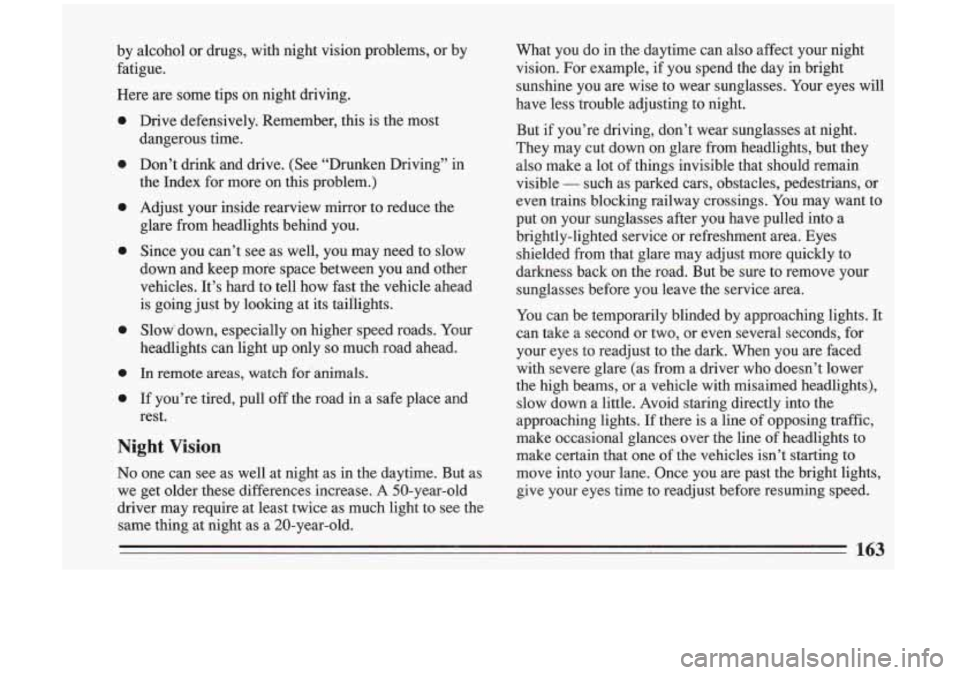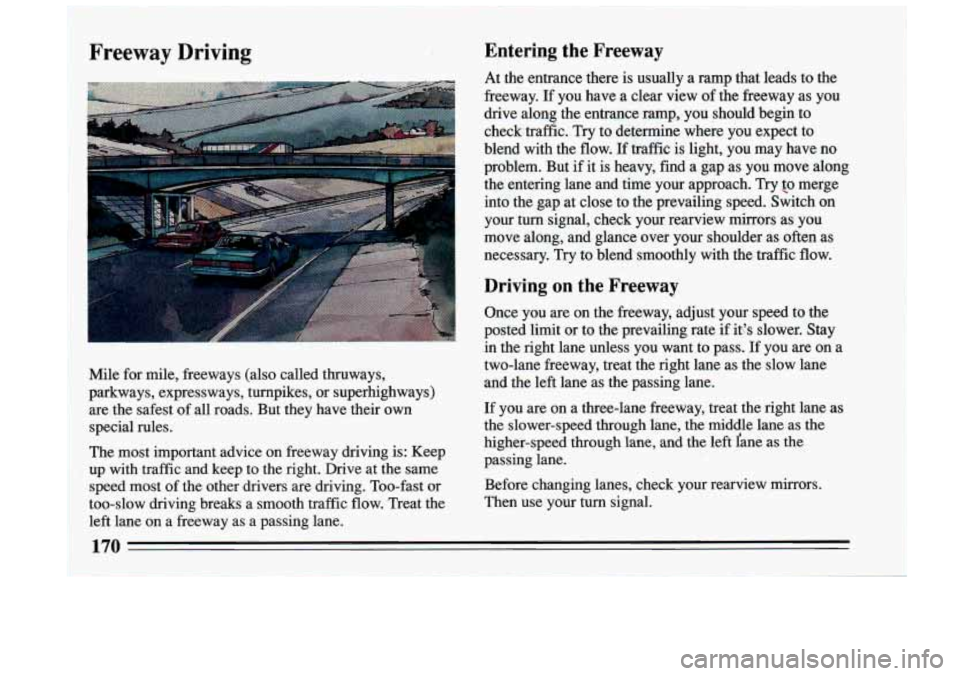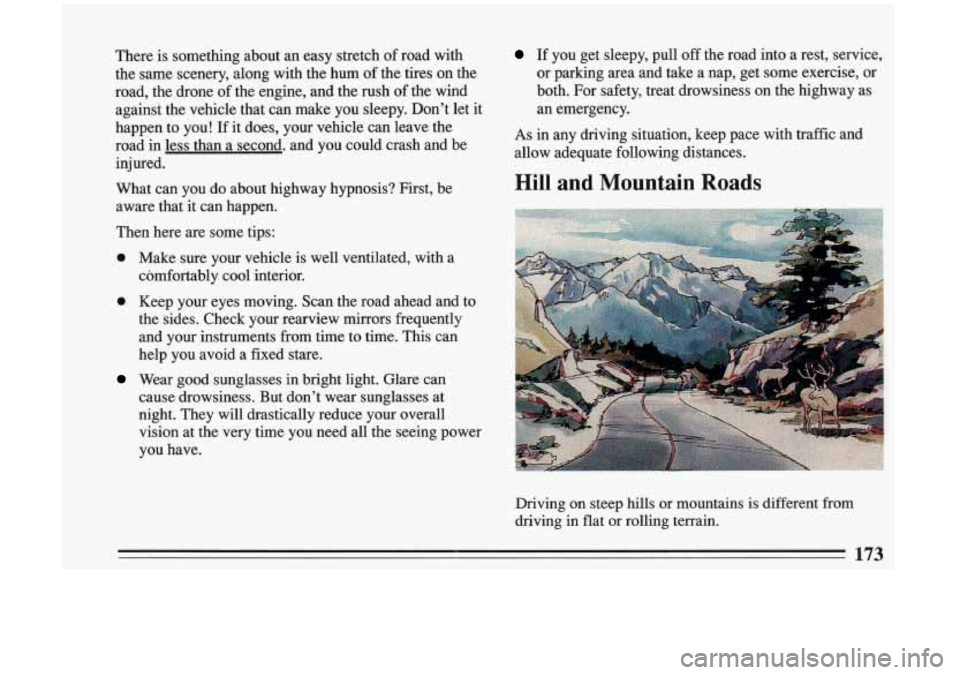Page 103 of 324
Cleaning Photocells
Use a cotton swab and glass cleaner to clean the two
photocells that make the mirror work.
Outside Mirrors
The electric mirror control is on the driver's door.
Move the switch to the right
(R) or left (L) to choose a
mirror. Press any
of the four buttons to move the mirror
in the direction desired.
Adjust each mirror
so you can just see the side of your
car and the area behind your car.
Heated Outside Rearview Mirror (Option)
The left outside mirror is heated when you turn on the
rear window defogger.
101
Page 125 of 324
Defrost
This setting will direct the
most air toward the
windshield. Use this when
there is fog
or ice on the
Rear Window Defogger
f
windshield.
Defrost will work better if you clear any ice or snow
from the air inlet area between the hood and the
windshield.
Blower speed will be controlled automatically, or you
can choose another speed by pushing the HI
or LO
buttons. The
lines you see
on the
rear window will warm the
glass. Press the button to
start warming your window.
After
10 minutes, it will go
off by itself, or by pressing
the button again will shut it
off. If you need additional
warming time, push the
button again.
If you have the outside
! heated rearview mirror option, the mirror heats
when the rear defogger is
turned on.
Page 165 of 324

by alcohol or drugs, with night vision problems, or by
fatigue.
Here are some tips on night driving.
0
0
0
0
0
0
0
Drive defensively. Remember, this is the most
dangerous time.
Don’t drink and drive. (See “Drunken Driving” in
the Index for more on this problem.)
Adjust your inside rearview mirror to reduce the
glare
from headlights behind you.
Since you can’t see as well, you may need to slow
down and keep more space between you and other
vehicles. It’s hard to tell how fast the vehicle ahead
is going just by looking at its tail’lights.
Slow’’ down, especially on higher speed roads. Your
headlights can light up only
so much road ahead.
In remote areas, watch for’animals.
If you’re tired, pull off the road in a safe place and
rest.
Night Vision
No one can see as well at night as in the daytime. But as
we get older these differences increase. A 50-year-old
driver may require at least twice as much light to see the
same thing at night as a 20-year-old. What you
do in the daytime can also affect your night
I
vision. For example, if you spend the day in bright
sunshine you are wise to wear sunglasses. Your eyes will
have less trouble adjusting to night.
But if you’re driving, don’t wear sunglasses at night.
They may cut down on glare from headlights, but they
also make a lot of things invisible that should remain
visible
- such as parked cars, obstacles, pedestrians, or
even trains blocking railway crossings. You may want to
put on your sunglasses after you have pulled into a
brightly-lighted service or refreshment area. Eyes
shielded from that glare may adjust more quickly to
darkness back on the road. But be sure to remove your
sunglasses before you leave the service area.
You can be temporarily blinded by approaching lights. It
can take a second or two, or even several seconds, for
your eyes
to readjust to the dark. When you are faced
with severe glare (as from a driver who doesn’t lower
the hi.gh beams, or a vehicle with misaimed headlights),
slow down a little. Avoid staring directly into the
approaching lights.
If there is a line of opposing traffic,
make occasional glances over the line of headlights to
make certain that one of the vehicles isn’t starting to
move into your lane. Once you are past the bright lights,
give
your eyes time to readjust before resuming speed.
163 ,
Page 172 of 324

'Freeway Driving Entering the Freeway
the entering lane and time your approach. Try lo merge
into the gap at close to the prevailing speed. Switch on
your turn signal, check your rearview mirrors as you
move along, and glance over your shoulder as often as
necessary.
Try to blend smoothly with the traffic flow.
Driving on the Freeway
Once.you are on the freeway, adjust your speed to the
posted limit or to the prevailing rate if it& slower. Stay
in the right lane unless you want to pass.
If you are on a
two-lane freeway, treat the right lane as the slow lane
and the left lane as the passing lane.
If you are on a three-lane freeway, treat the right lane as
the slower-speed through lane, the middle lane as the
higher-speed through lane, and the left fane as the
passing lane.
Before changing lanes, check your rearview mirrors.
Then use your
turn signal.
Mile for mile, freeways (also called thruways,
parkways, expressways, turnpikes, or superhighways) are the safest of all roads. But they have their own
special rules.
The most important advice on freeway driving is: Keep up with traffic and keep to the right. Drive at the same
speed most of the other drivers are driving. Too-fast 'or
too-slow driving breaks a smooth traffic flow. Treat the
left lane on a freeway as a passing lane.
170
Page 175 of 324

There is something about an easy stretch of road with
the same scenery, along with the hum of the tires on the
road, the drone of the engine, and the
rush of the wind
against the vehicle that can make you sleepy. Don't let it
happen to you! If it does, your vehicle can leave the
road in less than a second. and you could crash and be
injured.
What can you do about highway hypnosis? First, be
aware that
it can happen.
Then here are some tips:
0 Make sure your vehicle is well ventilated, with a
comfortably cool interior.
0 Keep your eyes moving. Scan the road ahead and to
the sides. Check your rearview mirrors frequently
and your instruments from time to time. This can
help you avoid a fixed stare.'
Wear good sunglasses in bright light. Glare can
cause drowsiness. But don't wear sunglasses at
night. They will drastically reduce your overall vision at the very time you need all the seeing power
you have.
If you get sleepy, pull off the road into a rest, service,
or parking area and take a nap, get some exercise, or
both. For safety, treat drowsiness on the highway as
an emergency.
As in any driving situation, keep pace with traffic and
allow adequate following distances.
Hill and Mountain Roads
Driving on steep hills or mountains is different from
driving in flat or rolling terrain.
'I
173